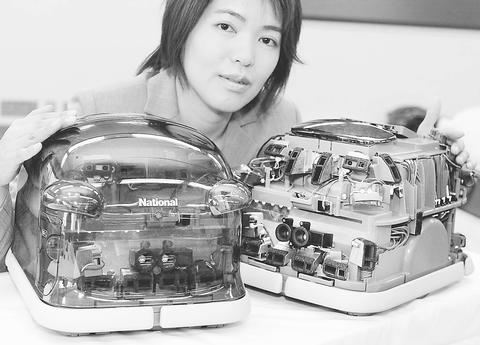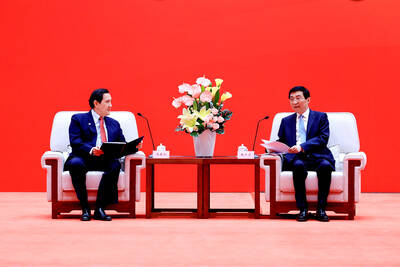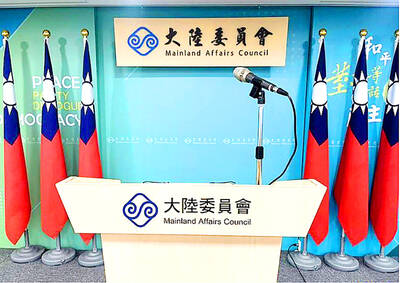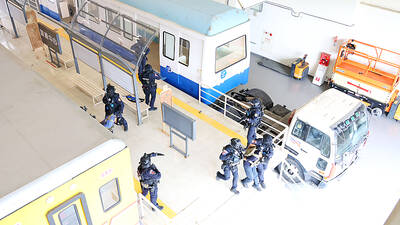The vacuum-cleaning robot from Japanese electronics manufacturer Matsushita Electric Industrial Co still crashes into chair legs and leaves lots of corners unswept.
But the unnamed test model, shown to reporters yesterday, is set to go on sale in three years with a price tag of Japanese yen 500,000 (US$3,800), the Osaka-based company said.
That's a target price counting on technological developments over the next few years that should bring down costs, officials said. The cordless machine, slightly bigger than a basketball, required Japanese yen 200 million (US$1.5 million) of research costs.

PHOTO: AFP
The company, which makes the Panasonic brand, has no export plans for the robot.
Matsushita said its autonomous-control technology can be used in other housekeeping robots that can work as a security guard or a caretaker for children or the elderly when equipped with features like cameras and mobile connections.
Eye-like lights glowing in the front and the back, the vacuuming robot comes with 50 sonic, infrared and other types of sensors so it turns before running into walls and avoids falling off steps.
Running for 55 minutes on a single battery charge, it figures out the size of a room by circling around it once and then travels horizontally and vertically to crisscross through the room to vacuum 92 percent of the floor space, Matsushita said.
It can't clean the edges because it's designed to stop 15cm before a wall and other obstacles that are at least 3cm wide.
"We have long been tackling the automation of domestic chores," said Matsushita director Yoshitaka Hayashi. "Robots will someday guard against fires and burglary in homes while people are asleep."
In a demonstration at Matsushita's Tokyo office, the vacuuming robot inched around a set similar to a living room, avoiding cabinets and furniture but left large portions near walls untouched. A person would have to use a regular vacuum cleaner to do a more thorough job, Matsushita said.
The robot took about nine minutes to finish the task, but officials acknowledged a person could do it in about five minutes. The robot also needs more work because it can get stuck under chairs and tables, they said.
The robot is designed to suck things up more powerfully and slow down when traveling over dusty areas.
Several of the robots will be tested in Japanese homes starting in May.
A number of Japanese companies are selling and developing robots for homes, although the offerings from Sony Corp, for example, are strictly for entertainment. Matsushita has developed vacuuming robots for industrial use, but they weren't designed to dodge obstacles.
Japan leads the world in robot use, a nation that accounts for nearly half of the new robots installed worldwide in 2000, according to the UN.

CHIP WAR: The new restrictions are expected to cut off China’s access to Taiwan’s technologies, materials and equipment essential to building AI semiconductors Taiwan has blacklisted Huawei Technologies Co (華為) and Semiconductor Manufacturing International Corp (SMIC, 中芯), dealing another major blow to the two companies spearheading China’s efforts to develop cutting-edge artificial intelligence (AI) chip technologies. The Ministry of Economic Affairs’ International Trade Administration has included Huawei, SMIC and several of their subsidiaries in an update of its so-called strategic high-tech commodities entity list, the latest version on its Web site showed on Saturday. It did not publicly announce the change. Other entities on the list include organizations such as the Taliban and al-Qaeda, as well as companies in China, Iran and elsewhere. Local companies need

CRITICISM: It is generally accepted that the Straits Forum is a CCP ‘united front’ platform, and anyone attending should maintain Taiwan’s dignity, the council said The Mainland Affairs Council (MAC) yesterday said it deeply regrets that former president Ma Ying-jeou (馬英九) echoed the Chinese Communist Party’s (CCP) “one China” principle and “united front” tactics by telling the Straits Forum that Taiwanese yearn for both sides of the Taiwan Strait to move toward “peace” and “integration.” The 17th annual Straits Forum yesterday opened in Xiamen, China, and while the Chinese Nationalist Party’s (KMT) local government heads were absent for the first time in 17 years, Ma attended the forum as “former KMT chairperson” and met with Chinese People’s Political Consultative Conference Chairman Wang Huning (王滬寧). Wang

CROSS-STRAIT: The MAC said it barred the Chinese officials from attending an event, because they failed to provide guarantees that Taiwan would be treated with respect The Mainland Affairs Council (MAC) on Friday night defended its decision to bar Chinese officials and tourism representatives from attending a tourism event in Taipei next month, citing the unsafe conditions for Taiwanese in China. The Taipei International Summer Travel Expo, organized by the Taiwan Tourism Exchange Association, is to run from July 18 to 21. China’s Taiwan Affairs Office spokeswoman Zhu Fenglian (朱鳳蓮) on Friday said that representatives from China’s travel industry were excluded from the expo. The Democratic Progressive Party government is obstructing cross-strait tourism exchange in a vain attempt to ignore the mainstream support for peaceful development

ELITE UNIT: President William Lai yesterday praised the National Police Agency’s Special Operations Group after watching it go through assault training and hostage rescue drills The US Navy regularly conducts global war games to develop deterrence strategies against a potential Chinese invasion of Taiwan, aimed at making the nation “a very difficult target to take,” US Acting Chief of Naval Operations James Kilby said on Wednesday. Testifying before the US House of Representatives Armed Services Committee, Kilby said the navy has studied the issue extensively, including routine simulations at the Naval War College. The navy is focused on five key areas: long-range strike capabilities; countering China’s command, control, communications, computers, cyber, intelligence, surveillance, reconnaissance and targeting; terminal ship defense; contested logistics; and nontraditional maritime denial tactics, Kilby